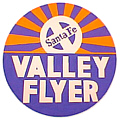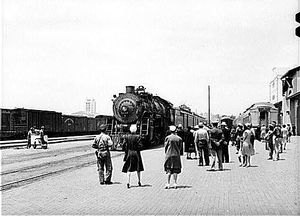Valley Flyer: Difference between revisions
imported>Robert A. Estremo (article body) |
imported>Robert A. Estremo mNo edit summary |
||
| Line 1: | Line 1: | ||
{{subpages}} | {{subpages}} | ||
[[Image:ATSF Valley Flyer at Fresno yard.jpg|thumb|right| | [[Image:ATSF Valley Flyer at Fresno yard.jpg|thumb|right|400px|{{ATSF Valley Flyer at Fresno yard.jpg/credit}}<br />The ''Valley Flyer'' pulls into the Santa Fe's [[Fresno, California|Fresno]] yard.]] | ||
[[Image:ATSF Valley Flyer drumhead.jpg|thumb|120px|right|{{ATSF Valley Flyer drumhead.jpg/credit}}<br />"[[Drumhead (sign)|Drumhead]]" logos such as this often adorned the ends of [[observation car]]s on the ''Valley Flyer''.]] | [[Image:ATSF Valley Flyer drumhead.jpg|thumb|120px|right|{{ATSF Valley Flyer drumhead.jpg/credit}}<br />"[[Drumhead (sign)|Drumhead]]" logos such as this often adorned the ends of [[observation car]]s on the ''Valley Flyer''.]] | ||
[[Image:Outside SD Union Station 1941.jpg|thumb|300px|right|{{Outside SD Union Station 1941.jpg/credit}}<br />The station platform at San Diego in the early days of World War II. The ''Valley Flyer'', filling in as train No. 70, the ''San Diegan'', is at the right.]] | [[Image:Outside SD Union Station 1941.jpg|thumb|300px|right|{{Outside SD Union Station 1941.jpg/credit}}<br />The station platform at San Diego in the early days of World War II. The ''Valley Flyer'', filling in as train No. 70, the ''San Diegan'', is at the right.]] | ||
| Line 9: | Line 9: | ||
Operation commenced on June 11, 1939. The train left Bakersfield daily at 6:30 a.m. and arrived in Oakland at 12:35 p.m., then returned south at 1:55 p.m., pulling into Bakersfield station at 8:00 p.m. Beginning on October 27, 1941 the ''Flyer'' (save for the lounge car) was used to transport troops as a section of the ''[[San Diegan]]'' on the Santa Fe's "Surf Line" run between [[Los Angeles, California|Los Angeles]] and [[San Diego, California|San Diego]]. In 1942, the trainset was discontinued and the passenger cars returned to pool service and repainted "Coach Green." The locomotives' black paint was restored and the running board panels removed. | Operation commenced on June 11, 1939. The train left Bakersfield daily at 6:30 a.m. and arrived in Oakland at 12:35 p.m., then returned south at 1:55 p.m., pulling into Bakersfield station at 8:00 p.m. Beginning on October 27, 1941 the ''Flyer'' (save for the lounge car) was used to transport troops as a section of the ''[[San Diegan]]'' on the Santa Fe's "Surf Line" run between [[Los Angeles, California|Los Angeles]] and [[San Diego, California|San Diego]]. In 1942, the trainset was discontinued and the passenger cars returned to pool service and repainted "Coach Green." The locomotives' black paint was restored and the running board panels removed. | ||
==Equipment== | ==Equipment== | ||
The motive power units alternated service.<ref>Jordan, pp. 66, 68: The steam-powered, all-heavyweight consist was headed by 4-4-2 Atlantic type locomotive No. 1369 and included three coaches, a lounges, and a baggage-club car. A diner was added in 1941.</ref> | The motive power units alternated service.<ref>Jordan, pp. 66, 68: The steam-powered, all-heavyweight consist was headed by 4-4-2 Atlantic type locomotive No. 1369 and included three coaches, a lounges, and a baggage-club car. A diner was added in 1941.</ref> | ||
Revision as of 21:50, 30 September 2014

The Valley Flyer pulls into the Santa Fe's Fresno yard.

"Drumhead" logos such as this often adorned the ends of observation cars on the Valley Flyer.
The Valley Flyer was a short-lived named passenger trains of the Atchison, Topeka and Santa Fe Railway (AT&SF). The all-heavyweight, "semi-streamlined" train operated between Bakersfield and Oakland, California (through the heart of California's San Joaquin Valley, hence the name) during the 1939–1940 Golden Gate International Exposition (also known as the 1939 World's Fair), located on "Treasure Island" in San Francisco Bay. Motive power consisted of a pair of aging, Baldwin Locomotive Works-built 1300 class type 4-6-2 "Pacific" steam-powered locomotives refurbished and specially-decorated for the train. It was the Santa Fe's first attempt at streamlining older steam power.
The locomotives had metal skirting applied along the sides, which was painted aluminum (as was the nose and smokestack) with red and yellow stripes, these being outlined by black pinstripes; the tenders were similarly decorated. A yellow "Circle and Cross" emblem backed by red "wings" was emblazoned across the front of the locomotive above the pilot deck, and on each side of the tender, which also featured a red "wing." The air-conditioned rolling stock was painted completely in aluminum, and had red and yellow stripes running along their sills, bordered with black pinstripes (somewhat akin to those found on Santa Fe's passenger diesel locomotives). Stripes on the combine unit spilt into two sets, with one set sweeping up to align with those on the locomotive tenders. Window shades were painted matte aluminum. The sides of the passenger cars bore the words "SANTA FE" in black, extra extended Railroad Roman letters. The design of the Valley Flyer's "drumhead" was inspired by that of its counterpart, the Golden Gate.
Operation commenced on June 11, 1939. The train left Bakersfield daily at 6:30 a.m. and arrived in Oakland at 12:35 p.m., then returned south at 1:55 p.m., pulling into Bakersfield station at 8:00 p.m. Beginning on October 27, 1941 the Flyer (save for the lounge car) was used to transport troops as a section of the San Diegan on the Santa Fe's "Surf Line" run between Los Angeles and San Diego. In 1942, the trainset was discontinued and the passenger cars returned to pool service and repainted "Coach Green." The locomotives' black paint was restored and the running board panels removed.
Equipment
The motive power units alternated service.[1]
- Baldwin 4-6-2 Pacific #1369
- Baldwin 4-6-2 Pacific #1376
- Combine Baggage-Barbershop-Buffet-Library #1302
- Lounge #1367
- Fred Harvey Company Diner #1467
- "Chair" car / Coach #3002
- "Chair" car / Coach #3005
- "Chair" car / Coach #3006
- 1369 was sold for scrap on November 6, 1951, and #1376 was likewise sold on August 22, 1950.
Notes and references
- ↑ Jordan, pp. 66, 68: The steam-powered, all-heavyweight consist was headed by 4-4-2 Atlantic type locomotive No. 1369 and included three coaches, a lounges, and a baggage-club car. A diner was added in 1941.
